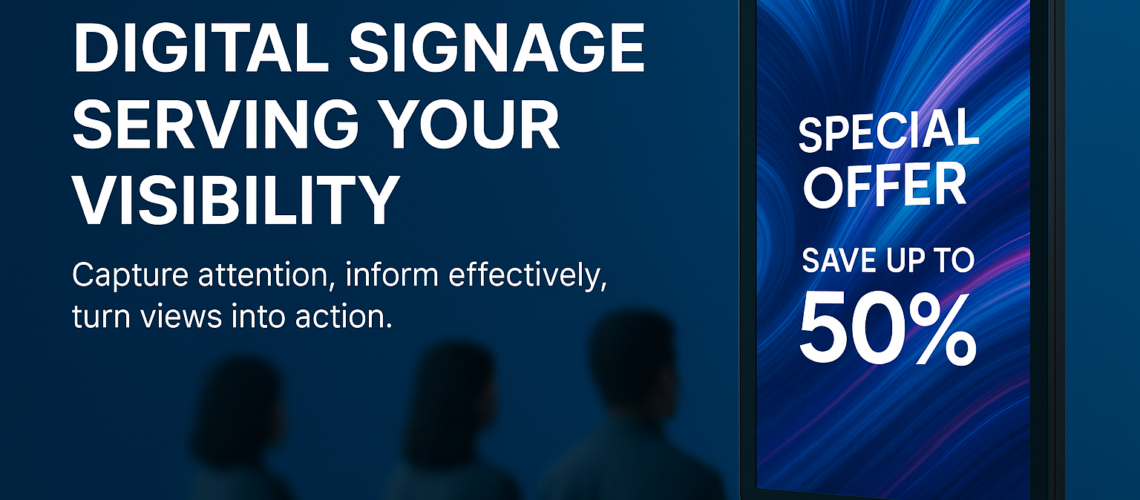Communication

Revolutionizing Communication with Digital Signage
In today’s fast-paced world, effective communication is key to maintaining a strong connection with your audience. Traditional methods of communication, such as static posters or paper-based signage, have become less impactful, as customers are increasingly looking for real-time, engaging, and dynamic content. This is where digital signage steps in, revolutionizing how businesses communicate, engage, and inform their audiences.
What is Digital Signage?
Digital signage is the use of digital displays—such as LED screens, projectors, and interactive kiosks—to communicate information, promotions, or content in real time. Unlike traditional signage, digital displays allow businesses to display dynamic, multimedia content that can be easily updated, changed, or scheduled remotely. This technology allows for the delivery of tailored messaging that resonates with the target audience, enhancing the overall experience.
Benefits of Digital Signage for Businesses
Digital signage offers businesses numerous benefits that traditional signage cannot provide. Here are just a few ways digital displays can transform communication:
1. Real-Time Updates and Flexibility
One of the key advantages of digital signage is the ability to make updates instantly. Whether you’re announcing flash sales, promoting new products, or sharing important news, the flexibility to change messages on-the-fly ensures that your content is always up-to-date. No more waiting days or weeks for the printing of new posters—simply log in to your content management system, update the message, and you’re ready to go.
2. Engaging and Interactive Content
Gone are the days of static, one-size-fits-all messaging. Digital signage allows businesses to captivate audiences with dynamic, interactive content that grabs attention and encourages engagement. Using video, animations, social media feeds, and even live data, digital displays provide a visually rich experience that is far more engaging than traditional print materials. This makes it easier for businesses to communicate their message in a way that resonates with the audience, resulting in better retention and understanding.
3. Increased Customer Interaction
Digital signage isn’t just a one-way communication tool—it’s an interactive experience. Touchscreen kiosks, QR codes, and live social media feeds enable customers to actively engage with your content. Whether it’s exploring a product catalog, entering a contest, or finding out more about a promotion, digital signage provides countless ways for customers to interact with your business. This engagement boosts customer satisfaction and builds a stronger, more personal connection with your brand.
4. Targeted Messaging
With digital signage, businesses can tailor their messaging based on factors such as time of day, audience demographics, and location. For example, a retail store can display different promotions in the morning and afternoon, catering to different customer segments. Corporate offices can display internal communications that are relevant to specific departments. This ability to target content in real time ensures that your message is always relevant and impactful.
5. Cost-Effective and Sustainable
While traditional signage can incur high costs in terms of printing and distribution, digital signage allows businesses to create and distribute content at a fraction of the cost. Plus, digital signage reduces the environmental impact by cutting down on the need for paper, making it a more sustainable choice in today’s eco-conscious world.
Applications of Digital Signage Across Industries
Retail:
In the retail sector, digital signage has become an essential tool for enhancing the customer shopping experience. Interactive displays allow customers to browse products, check out promotions, and get information in real time. By showcasing targeted advertisements and seasonal deals, retailers can drive sales and increase foot traffic. Digital signage also offers the flexibility to display dynamic pricing and personalized messages, enhancing the shopping experience and boosting customer satisfaction.
Hospitality:
Hotels, resorts, and restaurants can use digital signage to communicate with guests effectively. From check-in information to event schedules, restaurant menus to local attractions, digital displays provide guests with the information they need in a visually appealing and easily accessible format. Digital signage also allows businesses to display real-time updates, such as changes to booking schedules, event cancellations, or important announcements, keeping guests informed throughout their stay.
Corporate Environments:
In the corporate world, internal communication is just as important as external messaging. Digital signage enables businesses to communicate key information to employees in a way that is clear, concise, and easily accessible. From digital bulletin boards displaying company news and upcoming events to real-time dashboards tracking team performance, digital signage improves workflow and keeps employees connected and engaged.
Healthcare:
Hospitals, clinics, and medical facilities can use digital signage to streamline communication with patients and staff. Waiting room screens can display important health information, appointment schedules, or entertainment while patients wait. Digital signage can also be used in exam rooms or operating areas to keep staff informed about the latest protocols, procedures, and updates.
Transportation and Public Spaces:
Airports, train stations, and public transportation hubs benefit from digital signage by providing real-time updates on schedules, directions, and alerts. In these high-traffic locations, digital displays ensure that passengers are kept informed at all times, improving the overall experience and reducing confusion. Public spaces such as malls, museums, and stadiums also utilize digital signage to guide visitors, share event information, and enhance their experiences.
Future of Digital Signage
As technology continues to evolve, the potential of digital signage is limitless. Innovations like artificial intelligence (AI), augmented reality (AR), and 5G connectivity are further enhancing the capabilities of digital displays, making them smarter, more interactive, and more personalized. Businesses are now able to incorporate real-time customer data to adjust content based on behavior, location, and preferences, taking personalization to the next level.
The future of digital signage is not just about displaying information—it’s about creating an immersive experience that drives engagement, enhances communication, and increases sales. As this technology continues to advance, digital signage will become an even more integral part of the communication strategy for businesses across industries.
Why Choose Digital Signage?
Digital signage is the perfect solution for businesses looking to improve communication, increase customer engagement, and streamline operations. Whether you’re a retail business looking to captivate shoppers or a corporate office wanting to boost internal communication, digital signage provides the flexibility, cost-effectiveness, and impact that traditional methods simply can’t match. It’s time to step into the future of communication—digitally.
Ready to transform your business communication? Get in touch with us today to learn more about how digital signage can help your business thrive in the digital age.

